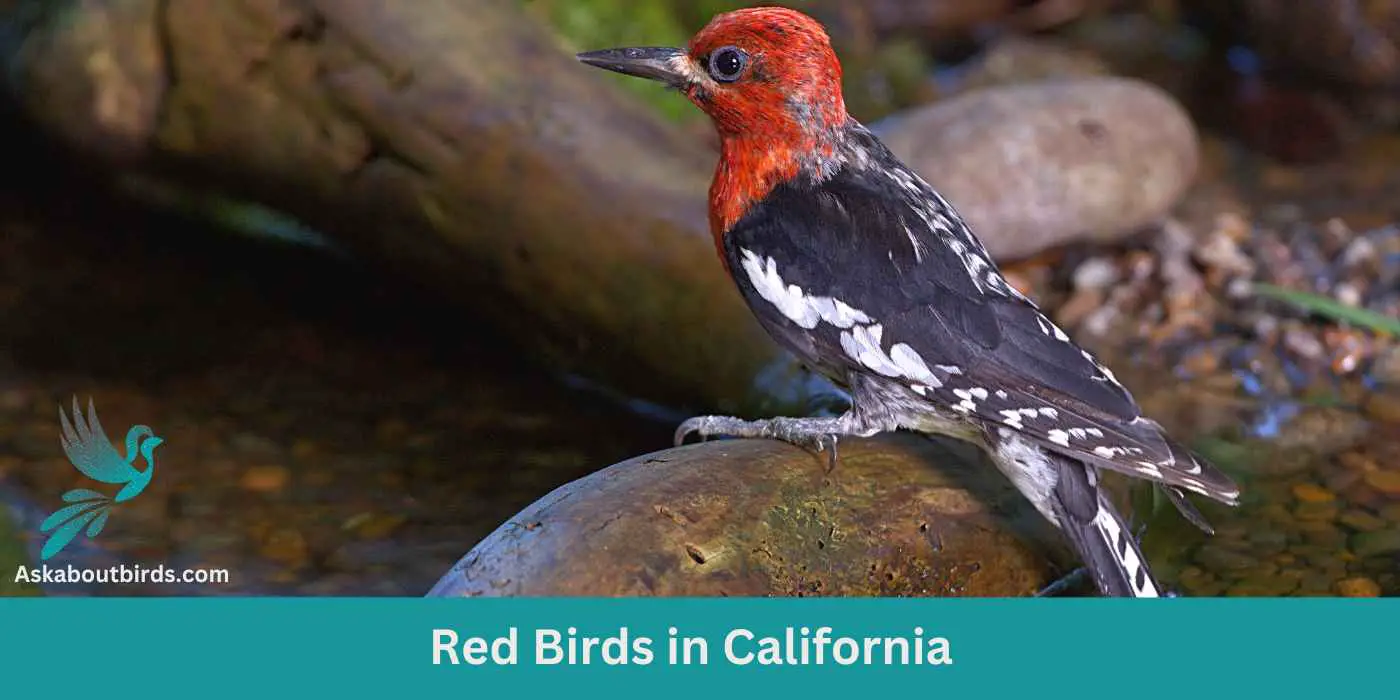Journey through California’s diverse landscapes, from its sun-kissed coasts to majestic mountain ranges, as we introduce you to 13 resplendent red birds that grace the Golden State.
From the cool, mist-kissed coastal redwoods of the north to the hot, sprawling deserts of the south, and from the fertile Central Valley to the rugged Sierra Nevada mountains, California’s varied habitats provide a myriad of niches for avian life.
Red Birds Found In California
Its unique positioning along the Pacific Flyway—a major migratory path—also means that the state plays host to countless birds as they travel seasonally, further enriching its avian diversity. This blend of resident and migratory species, all navigating a mosaic of habitats, makes California one of North America’s premier birdwatching destinations.
Northern Cardinal


| Feature | Measurement |
|---|---|
| Scientific Name | Cardinalis cardinalis |
| Length | 8.3 – 9.1 in |
| Wingspan | 9.8 – 12.2 in |
| Weight | 1.19 – 2.29 oz |
The Northern Cardinal is an iconic North American bird, easily recognized by its vibrant color and melodious song.
Appearance: Male Northern Cardinals are a brilliant scarlet red, while females display a more subdued reddish olive. Both sexes have a distinctive black ‘mask’ on their face around the bill and a pointed crest on their head. The bird’s beak is robust, cone-shaped, and bright orange in color.
Diet: Northern Cardinals are primarily granivorous, with a diet largely consisting of seeds and grains. They also eat fruits and insects. These birds typically feed off the ground and are frequent visitors to bird feeders.
Reproduction: Northern Cardinals are monogamous, and a pair will breed together for life. The female typically builds a well-hidden nest in a dense thicket or shrub. She lays 2-5 eggs per clutch, which she incubates for around two weeks.
Summer Tanager


| Feature | Measurement |
|---|---|
| Scientific Name | Piranga rubra |
| Length | 6.7 in |
| Wingspan | 28 to 30 cm |
| Weight | 29 g |
The Summer Tanager is a medium-sized songbird admired for its radiant plumage and melodious song.
Appearance: Male Summer Tanagers are an impressive bright red, while females and juveniles present a softer, yellow-orange color. Both genders have a large, slightly hooked bill and relatively short tail.
Diet: Summer Tanagers primarily feed on insects, including bees and wasps, which they catch in flight or pick off vegetation. They are also known to eat fruits and berries, making them helpful in controlling pest populations and seed dispersal.
Reproduction: The female Summer Tanager builds a loose, shallow cup-shaped nest out of twigs and grass, usually hidden in the foliage of trees. The female typically lays 3-5 eggs, which she will incubate for about two weeks.
Western Tanager

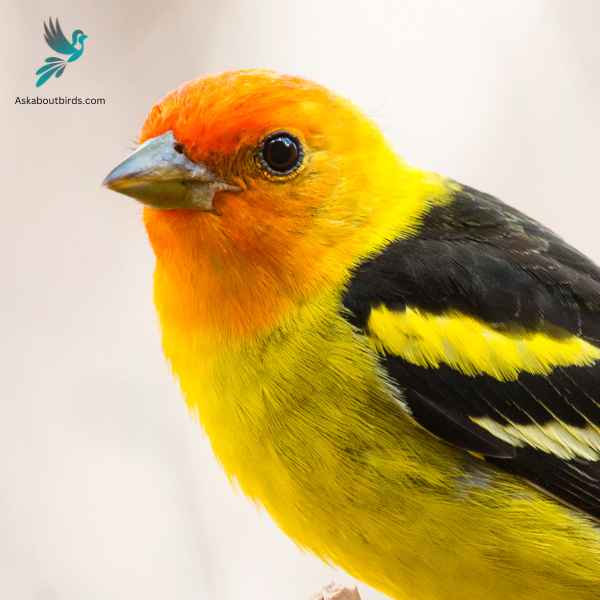
| Feature | Measurement |
|---|---|
| Scientific Name | Piranga ludoviciana |
| Length | 6.3-7.5 in |
| Wingspan | 11.5 in |
| Weight | 24-36 g |
The Western Tanager is a vibrant songbird that graces the forests and woodlands of the western regions of North America, enchanting observers with its colorful plumage and melodious song.
Appearance: The male Western Tanager is renowned for its bright yellow body contrasted with a striking red head and black wings and tail. The females are more subdued in hue, primarily being yellow with grayish wings and back, and lacking the brilliant red head of the males.
Diet: Western Tanagers primarily feed on insects, especially when breeding, but they also incorporate a significant amount of fruits and berries into their diet, especially during migration and winter.
Reproduction: Western Tanagers build their nests high in coniferous trees, often well concealed from potential predators. The female usually lays a clutch of 3 to 5 eggs and takes the primary role in incubation, while both parents are involved in feeding the chicks after they hatch.
Scarlet Tanager


| Feature | Measurement |
|---|---|
| Scientific Name | Piranga olivacea |
| Length | 6.3 to 7.5 in |
| Wingspan | 9.8 to 11.8 in |
| Weight | 23.5 to 38 g |
The Scarlet Tanager is a strikingly colorful bird known for its brilliant plumage and distinctive song.
Appearance: Male Scarlet Tanagers are notable for their vibrant scarlet bodies contrasted with black wings and tail, making them one of the most intensely colored birds. Females and juveniles, on the other hand, have a subdued olive-yellow body color with darker wings and tail.
Diet: The diet of the Scarlet Tanager is largely made up of insects, including beetles, cicadas, aphids, and others. They are adept flycatchers, seizing insects in mid-air or picking them off foliage. They also consume fruits and berries, especially during migration and in their winter habitats.
Reproduction: The female Scarlet Tanager builds a cup-shaped nest using twigs, rootlets, and grass, typically well-hidden in the dense foliage of trees. She lays 3 to 5 eggs and incubates them for about two weeks.
Red-headed Woodpecker

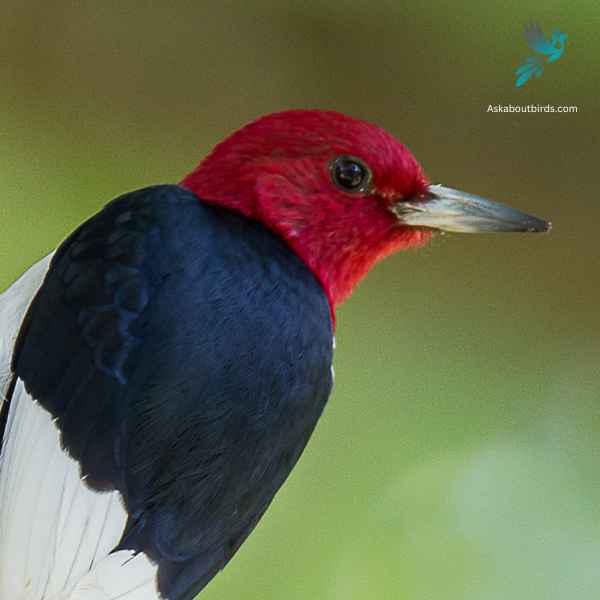
| Feature | Measurement |
|---|---|
| Scientific Name | Melanerpes erythrocephalus |
| Length | 7.5–9.1 in |
| Wingspan | 16.5 in |
| Weight | 2.0–3.2 oz |
The Red-headed Woodpecker is a striking forest bird with a bold tri-colored pattern.
Appearance: This woodpecker features a completely red head and neck, contrasting starkly with its white underparts and black wings. Its wings also have large white patches which are conspicuous in flight.
Diet: Red-headed Woodpeckers have a varied diet including insects, seeds, fruits, berries, and occasionally even the eggs of other birds. They’re also known to store food by wedging it into crevices in bark.
Reproduction: These woodpeckers nest in cavities which they excavate in dead wood or dead parts of live trees. These cavities can be found anywhere from 2 to 80 feet off the ground.
Red-breasted Sapsucker
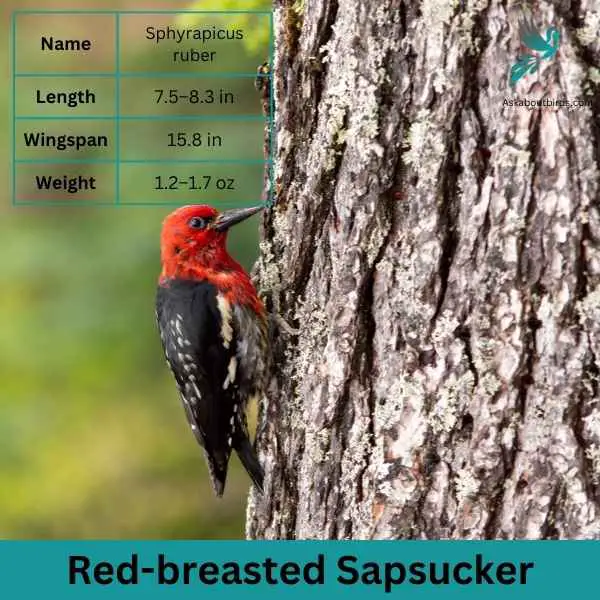
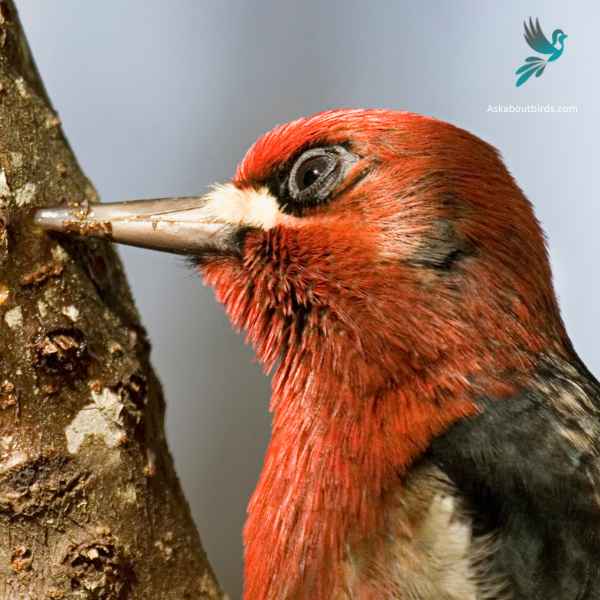
| Feature | Measurement |
|---|---|
| Scientific Name | Sphyrapicus ruber |
| Length | 7.5–8.3 in |
| Wingspan | 15.8 in |
| Weight | 1.2–1.7 oz |
The Red-breasted Sapsucker is a medium-sized woodpecker known for its vibrant coloration and distinctive foraging habits.
Appearance: This bird is primarily recognizable by its bright red head, breast, and flanks. The wings are black with white barring, and there’s a prominent white stripe running vertically down the wing. Its back is barred with black and white.
Diet: True to their name, Red-breasted Sapsuckers drill series of small holes in trees to feed on sap. They also consume insects attracted to this sap, as well as berries and fruits when available.
Reproduction: Red-breasted Sapsuckers create nest cavities in dead or decaying trees, and sometimes in living trees where the heartwood is decayed.
Red-naped Sapsucker


| Feature | Measurement |
|---|---|
| Scientific Name | Sphyrapicus nuchalis |
| Length | 7.5-8.5 in |
| Wingspan | 16 in |
| Weight | 1.2-1.7 oz |
The Red-naped Sapsucker is a medium-sized woodpecker commonly found in forests across the western North America, especially in mixed coniferous woods and aspen groves.
Appearance: This woodpecker is distinguished by its black-and-white barred pattern on the back and wings. A key feature is the bright red patch on the back of the head, which gives the bird its name. Both sexes have a white stripe down the side of the face, though males have a red patch on the throat, whereas females have a white one.
Diet: Red-naped Sapsuckers are named for their habit of drilling rows of shallow holes into tree bark to feed on sap and the insects attracted to it. They also consume ants, beetles, and caterpillars, and will sometimes eat fruits and berries.
Reproduction: These woodpeckers excavate nest cavities in trees, often selecting dead or decaying trees or limbs. After carving out a cavity, the female typically lays a clutch of 4 to 7 eggs. Both parents share responsibilities for incubation and feeding the chicks once they hatch.
House Finch


| Feature | Measurement |
|---|---|
| Scientific Name | Haemorhous mexicanus |
| Length | 5–6 in |
| Wingspan | 8–10 in |
| Weight | 0.6–0.9 oz |
The House Finch is a small songbird widely distributed across North America and is commonly found in urban and suburban areas.
Appearance: Males of this species are brightly colored with crimson faces and throats, which can extend to the chest and back, while their flanks have streaks. The female is streaked brown and lacks the red coloring. Both have a square-tipped tail and a distinctively long, flat-topped bill.
Diet: House Finches primarily eat seeds, grains, and berries. They have a particular fondness for sunflower seeds and can be commonly seen at bird feeders. Occasionally, they will also consume insects, especially during the breeding season.
Reproduction: House Finches are cavity-nesters and might choose ledges, vents, ledges, and other urban settings. They might also utilize trees or shrubs. Their nests can be made of a wide array of materials, from feathers to twigs.
Purple Finch


| Feature | Measurement |
|---|---|
| Scientific Name | Haemorhous purpureus |
| Length | 4.7–6.3 in |
| Wingspan | 4.7–6.3 in |
| Weight | 0.6–1.1 oz |
The Purple Finch is a vibrant songbird often mistaken for its close relative, the House Finch, but it exhibits a different hue and patterns.
Appearance: Males are raspberry red on the head, throat, and breast, with streaky brown backs and wings. The intensity of the red can vary among individuals. Females are brown and streaked all over but might show a slight blush on the face. They lack the strong facial patterns seen in female House Finches.
Diet: Purple Finches primarily consume seeds, with a preference for sunflower seeds, dandelion seeds, and buds. They also eat insects and berries, especially during the breeding season.
Reproduction: These finches often nest in conifers or mixed woodlands. The nest, typically located on a horizontal branch, is made from twigs and grass, then lined with feathers.
Red Crossbill
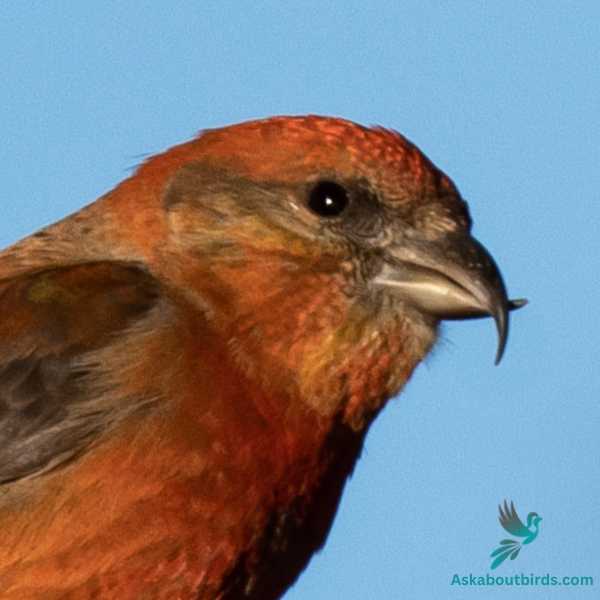

| Feature | Measurement |
|---|---|
| Scientific Name | Loxia curvirostra |
| Length | 20 cm |
| Wingspan | 27–29 cm |
| Weight | 40-53 g |
The Red Crossbill is a peculiar bird species, celebrated for its unique beak structure and vibrant coloration.
Appearance: Red Crossbills are named for their distinctive crossed mandibles, which are adapted to extracting seeds from conifer cones. Male Red Crossbills are usually bright red or orange, while females and juveniles are greenish-yellow. All have dark wings and notched tails.
Diet: The diet of the Red Crossbill is primarily composed of conifer seeds, their unique beak allowing them to access these seeds with ease. This diet includes seeds from pine, spruce, and other types of coniferous trees. They are also known to consume some insects.
Reproduction: Red Crossbills are known for their flexible breeding season, which can occur any time of the year when there is an abundance of food. They typically nest in conifers, where the female lays a clutch of 3 to 4 eggs.
Cassin’s Finch

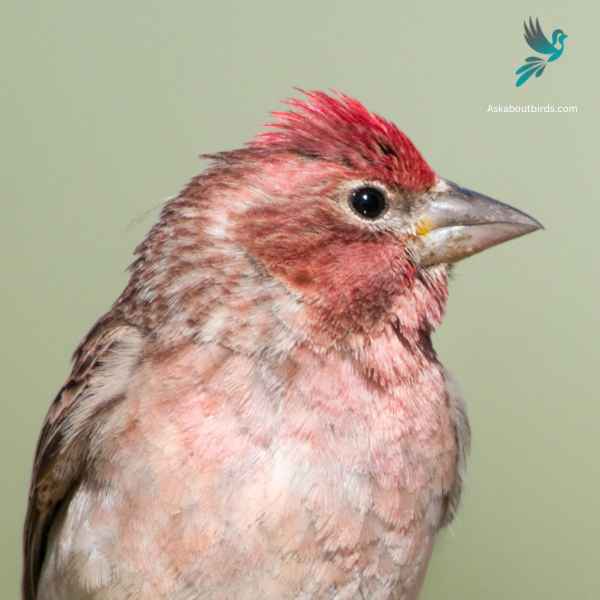
| Feature | Measurement |
|---|---|
| Scientific Name | Haemorhous cassinii |
| Length | 6.0-6.5 in |
| Wingspan | 9.5-10.5 in |
| Weight | 0.8-1.0 oz |
The Cassin’s Finch is a small songbird known for its melodic song and affinity for high-elevation forests.
Appearance: Male Cassin’s Finches are pinkish-red on the crown and throat, contrasting with their streaked brown back and wings. Females lack the bright coloring, appearing streaked brown throughout with a pale eyebrow stripe. Both sexes have a notched tail and a slightly curved bill.
Diet: Cassin’s Finches mainly feed on seeds, particularly from conifers. They also eat insects, especially during the breeding season. Their feeding habits often bring them to bird feeders where they readily eat sunflower seeds.
Reproduction: Cassin’s Finches nest in trees, preferring coniferous forests. The nest is made from twigs, grasses, and feathers. Typically, the female lays 3 to 5 eggs and handles most of the incubation. Both parents partake in feeding the fledglings once they hatch.
Pine Grosbeak

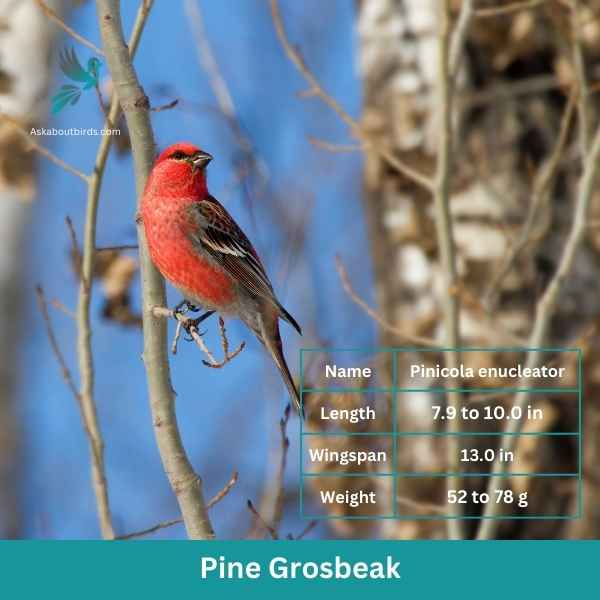
| Feature | Measurement |
|---|---|
| Scientific Name | Pinicola enucleator |
| Length | 7.9 to 10.0 in |
| Wingspan | 13.0 in |
| Weight | 52 to 78 g |
The Pine Grosbeak is a striking bird native to the northern regions of North America, often found in coniferous forests. Both males and females have a plump and robust body with a large beak adapted for eating seeds. The male Pine Grosbeak displays a vibrant reddish-pink plumage, while the female has a more subdued grayish-brown coloration.
These birds are typically seen in small flocks, foraging for food in trees and on the ground. They have a preference for seeds, particularly those from various conifer species. The Pine Grosbeak uses its strong bill to crack open the cones of tall trees and extract the seeds, but they also consume berries and small fruits when available.
Vermilion Flycatcher
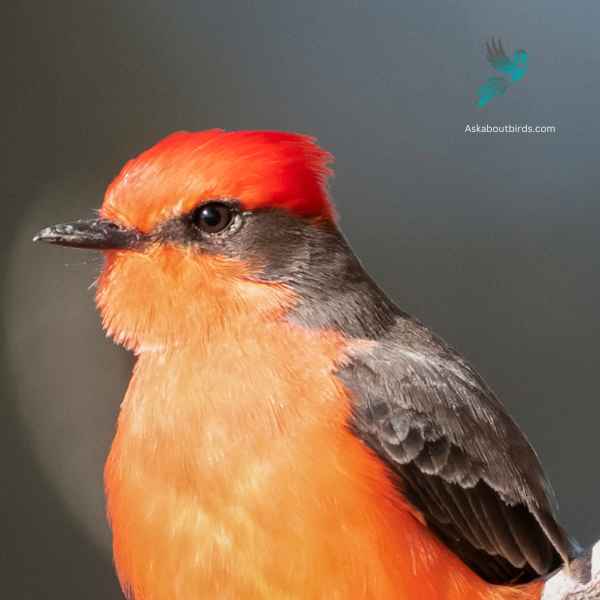

| Feature | Measurement |
|---|---|
| Scientific Name | Pyrocephalus obscurus |
| Length | 5.1–5.5 in |
| Wingspan | 9.4 to 9.8 in |
| Weight | 11 to 14 g |
The Vermilion Flycatcher is a small and colorful bird native to the Americas. The male Vermilion Flycatcher is a striking sight, displaying a vibrant red plumage on its head, breast, and underparts, contrasting with its brown wings and black tail below. Females, on the other hand, have more muted colors, featuring a pale yellowish belly and grayish-brown upperparts.
Vermilion Flycatchers are known for their lively and acrobatic flight displays, which they perform during courtship or to defend their territories. They often sing a series of soft, whistled notes while engaged in these aerial displays. They construct cup-shaped nests, usually in shrubs or low trees, where females lay their eggs and raise their young.
Where to Spot California’s Red Birds
California’s vast terrains offer some of the continent’s most spectacular birdwatching spots. Here are the top locales renowned for their avian diversity, especially for those in pursuit of resplendent red birds:
- Point Reyes National Seashore: A migratory hotspot, this coastal gem provides a backdrop of dramatic cliffs and sprawling beaches, making it a prime location for spotting an array of bird species, including the vibrant Western Tanager.
- Salton Sea: Located in the state’s southeastern desert, this saline lake is a vital stopover for many migrating birds. Here, you might catch a glimpse of the rare Vermilion Flycatcher against the stark desert landscape.
- Monterey Bay: With its rich marine ecosystem, the bay attracts numerous seabirds and shorebirds. The adjacent coastal habitats and forests are also home to land birds like the Summer Tanager.
- Big Morongo Canyon Preserve: A desert oasis, this preserve near Joshua Tree is a birdwatcher’s paradise with its riparian habitats attracting species like the House Finch and occasional Northern Cardinal.
- Tule Lake National Wildlife Refuge: Situated near the Oregon border, this refuge is part of the Pacific Flyway and draws a multitude of both waterfowl and land birds, making it a birdwatching haven all year round.
| State’s Red Birds | Top Birdwatching Spots |
|---|---|
| Oregon’s Red Birds | 1. Malheur National Wildlife Refuge 2. Mount Hood National Forest 3. Yaquina Head Outstanding Natural Area |
| Nevada’s Red Birds | 1. Ruby Mountains 2. Ash Meadows National Wildlife Refuge 3. Red Rock Canyon National Conservation Area |
| Arizona’s Red Birds | 1. Madera Canyon 2. Sedona Red Rock Country 3. Chiricahua Mountains |
FAQs on Red Bird Species Found in California
What red birds are common year-round residents in California?
In California, the adult male House Finches are one of the common red birds that are year-round residents. They boast bright red feathers, particularly on their heads and chests, which make them stand out in mixed forests and forest edges. Another year-round resident with striking red plumage is the male Northern Cardinal, especially noticeable with its raspberry red head and pale pink body, although they are less common in California than in the eastern U.S.
Which medium-sized bird with bright red plumage frequents the bird feeders in California?
The Summer Tanager males, medium-sized birds adorned with bright red plumage, are known to visit bird feeders in California, especially those filled with black oil sunflower seeds. They’re particularly prevalent in willow trees and mixed forests, making them a delightful sight for bird enthusiasts in both Northern and Southern California.
Are there migratory red birds that visit California during specific seasons?
Yes, the Western Tanager, recognized by its bright yellow-green body and brilliant red head, is a migratory bird that visits California during the breeding season. While they feed on flying insects, they can also be attracted to backyards with bird feeders stocked with sunflower seeds.
What differentiates the adult male House Finches from other red birds in California?
Adult male House Finches are characterized by their bright red feathers, particularly around the head and chest regions. They often have brown streaks on their underparts and display two white wing bars on their dark gray wings. This distinct color combination, paired with their frequent visits to bird feeders, makes them easily identifiable among the red birds in California.

